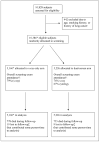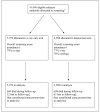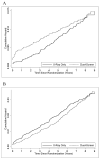Randomized controlled trials of the efficacy of lung cancer screening by sputum cytology revisited: a combined mortality analysis from the Johns Hopkins Lung Project and the Memorial Sloan-Kettering Lung Study
- PMID: 19637354
- PMCID: PMC2767423
- DOI: 10.1002/cncr.24545
Randomized controlled trials of the efficacy of lung cancer screening by sputum cytology revisited: a combined mortality analysis from the Johns Hopkins Lung Project and the Memorial Sloan-Kettering Lung Study
Abstract
Background: : Two randomized controlled trials of lung cancer screening initiated in the 1970s, the Johns Hopkins Lung Project and the Memorial Sloan-Kettering Lung Study, compared 1 arm that received annual chest X-ray and 4-monthly sputum cytology (dual-screen) to a second arm that received annual chest X-ray only. Previous publications from these trials reported similar lung cancer mortality between the 2 groups. However, these findings were based on incomplete follow-up, and each trial on its own was underpowered to detect a modest mortality benefit.
Methods: : The authors estimated the efficacy of lung cancer screening with sputum cytology in an intention-to-screen analysis of lung cancer mortality, using combined data from these trials (n = 20,426).
Results: : Over (1/2) of squamous cell lung cancers diagnosed in the dual-screen group were identified by cytology; these cancers tended to be more localized than squamous cancers diagnosed in the X-ray only arm. After 9 years of follow-up, lung cancer mortality was slightly lower in the dual-screen than in the X-ray only arm (rate ratio [RR], 0.88; 95% confidence interval [CI], 0.74-1.05). Reductions were seen for squamous cell cancer deaths (RR, 0.79; 95% CI, 0.54-1.14) and in the heaviest smokers (RR, 0.81; 95% CI, 0.67-1.00). There were also fewer deaths from large cell carcinoma in the dual-screen group, although the reason for this is unclear.
Conclusions: : These data are suggestive of a modest benefit of sputum cytology screening, although we cannot rule out chance as an explanation for these findings. Cancer 2009. (c) 2009 American Cancer Society.
Figures




References
-
- United States Preventive Services Task Force. Screening for cervical cancer: recommendations and rationale. Am J Nurs. 2003;103:101–109. - PubMed
-
- Saccomanno G, Saunders RP, Ellis H, Archer VE, Wood BG, Beckler PA. Concentration of carcinoma or atypical cells in sputum. Acta Cytol. 1963;7:305–310. - PubMed
-
- Byers T, Wolf HJ, Franklin WA, et al. Sputum cytologic atypia predicts incident lung cancer: defining latency and histologic specificity. Cancer Epidemiol Biomarkers Prev. 2008;17:158–162. - PubMed
-
- Prindiville SA, Byers T, Hirsch FR, et al. Sputum cytological atypia as a predictor of incident lung cancer in a cohort of heavy smokers with airflow obstruction. Cancer Epidemiol Biomarkers Prev. 2003;12:987–993. - PubMed
-
- Tockman MS, Frost JK, Stitik FP, Levin ML, Ball WC, Jr, Marsh BR. Screening and detection of lung cancer. In: Aisner J, editor. Lung Cancer. New York: Churchill Livingstone; 1985. pp. 25–40.
Publication types
MeSH terms
Grants and funding
LinkOut - more resources
Full Text Sources
Medical

